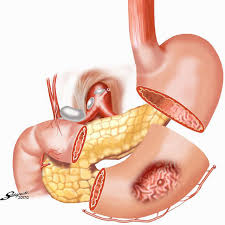Laparoscopic Surgery for Gastric Cancer is also known as laparoscopic Gastrectomy. It is a minimal invasive surgical procedure in which the surgeon removes the tumour in the stomach, through the use of a laparoscope and surgical instruments. The surgery is conducted by an expert Surgical Oncologists. The procedure is conducted to:
- Remove cancerous part of the stomach.
- If the cancer cells have spread throughout stomach, the whole stomach is removed.
- To lymph nodes near the stomach which have been affected by cancer cells.
Why Laparoscopic Surgery for Gastric Cancer is required
The treatment of Gastric cancer through laparoscopic techniques is highly preferred by medical experts or the following reasons:
- Smaller incisions are required for the surgery.
- Reduced post operative pain.
- Reduced recovery time.
- Shorter hospital stay.
- Smaller amount of complications after the surgery.
How the procedure is done
Before the procedure starts the patient is administered with general anaesthesia. A catheter is inserted to monitor the urine output of the patient. Then a tube known as the nasogastric tube is inserted through the nose down to the stomach, so that abdomen can be cleaned with an antiseptic solution. A laparoscope is inserted through a small incision to monitor the exact condition of the affected area and to monitor the removal procedure during the surgery. The surgeon makes two three small incision in the abdominal area, through the surgical instruments are inserted to conduct the surgery. The surgeon operates the affected part of the stomach and removes it along with the tumours or ulcers. If lower part is operated upon the stomach is attached to the small intestine, whereas if the upper part is operated upon then the oesophagus is attached to the lower part of the stomach. After the procedure is over the surgeon stitches all the incisions and they are dressed appropriately.
Types of Laparoscopic Gastrectomy Techniques
Laparoscopic treatment of Gastric cancer is done by the following techniques:
Endoscopic Mucosal Resection:
It is performed in the mucosa and sub mucosa area. A endoscope is inserted through the intestine to treat a less than two centimetre tumour or clearance of a lymph node.
Laparoscopic Assisted Distal Gastrectomy (LADG):
This procedure is used to remove advance cancerous cells. Apart from removing the cancer cells in the stomach and nearby lymph nodes, it is also used to remove lymph nodes or tumours located at the branches of the celiac arteries.
Before Laparoscopic Surgery for Gastric Cancer
Before the procedure the vital of the patient like temperature, blood pressure, blood sugar etc. will be taken. The patient may also be asked to go for blood test, CT scan, ultrasound, endoscopy, ECG,EEG X-Ray and other such tests. Intake of food and fluids will be stopped few hours before the surgery.
After Laparoscopic Surgery for Gastric Cancer
After the surgery the patient is sent to the post operation room where he is kept for a few hours under observation. Then he is shifted to the ICU or Warding depending on the condition of the patients health. The patient is not allowed to eat or drink anything immediately after the surgery. The patient may have to stay in the hospital for a couple of days. On discharge the doctor will prescribe medicines and advise on how to take care of the patient. He will call him for regular follow up visits. It takes few weeks for the patient to return to his normal routine life.
Risks involved
- Infection in the incision site.
- Bleeding after the surgery.
- Complications due to anaesthesia.
- Damage to nearby tissues Sweating, nausea and vomiting.
- Palpitation of the heart.
- Abdominal bloating and pain.

